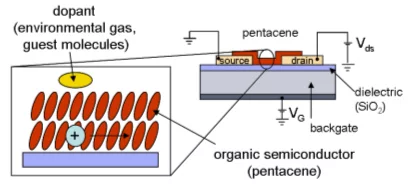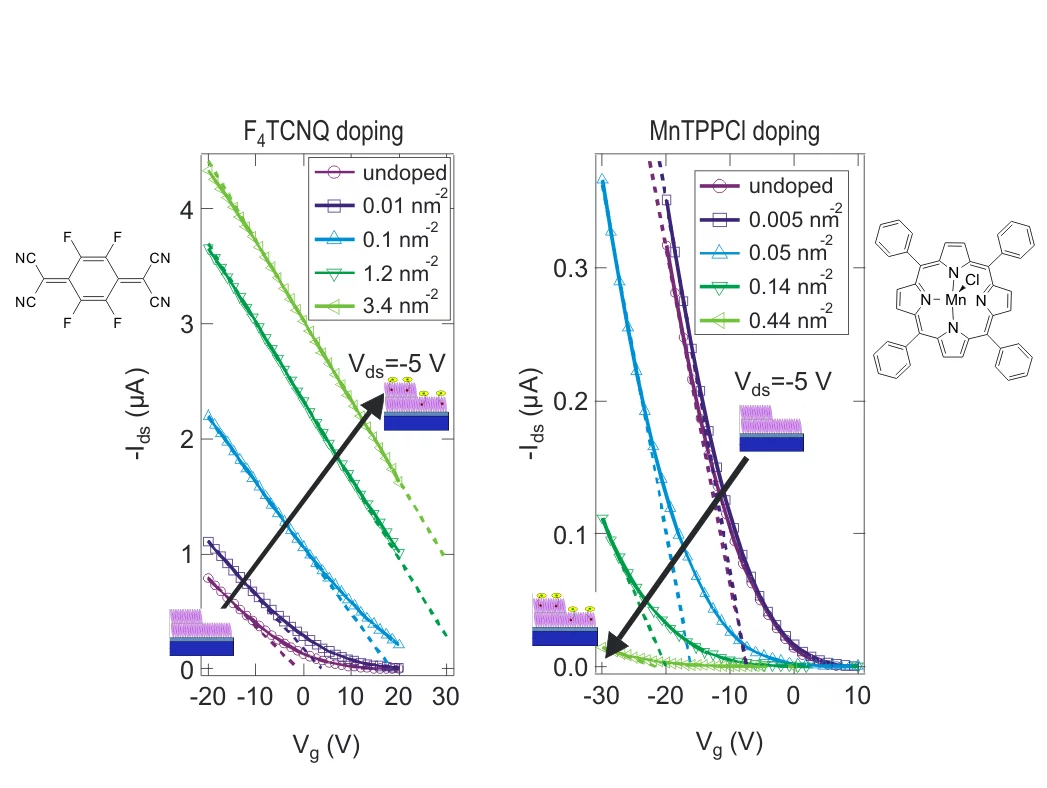Organic semiconductors are of interest for organic devices such as OLED, solar cells and organic thin film transistors. For such devices it is important to achieve low contact resistance at the metal-organic semiconductor interface, especially for small channel length, and to control the charge carrier density for improved device performance and to obtain specific functionalities. We address these problems by studying the doping of organic thin film transistors with molecular dopants. Especially we investigate the effect of surface doping with different organic molecules on a pentacene thin film transistor. Our transistors consist of only few (2.5-10 ML) monolayer thick active material and both the deposition as well as the electrical characterisation is done in situ in high vacuum.
We study the doping effects of molecular dopants in organic thin film transistors (TFTs) where we use pentacene as the active organic semiconductor material. Pentacene has a high mobility comparable to the one of amorphous silicon and is a p-type semiconductor. The TFTs consist of a highly doped silicon substrate with a SiO2 layer for the back gate and bottom gold contacts on which the pentacene is evaporated in-situ in high vacuum (Fig. 1).
Doping of such a pentacene TFT can be achieved in two ways: i) by coevaporating pentacene with a small amount of dopant molecules and ii) by surface doping, i.e. by evaporating sub-monolayer films of the dopant molecules on top of the pentacene TFT. In both case we investigate the effect of doping on the transport measurement, e.g. by observing a change of the threshold voltage.
Pentacene doping by coevaporation with the strong acceptor molecule F4TCNQ induces a decrease of the contact resistance by a factor of 20 [1]. Temperature dependent measurements showed that F4TCNQ doping reduces the injection barrier at the pentacene-Au interface and creates acceptor states just below the HOMO level of Pentacene [2].
Surface doping gives us the possibility to gradually increase the doping concentration on one single device and allows easily the study of different dopants. We could achieve both a positive (F4TCNQ) and a negative (MnTPPCl) shift of the threshold voltage (Fig. 2), as well as no change in the transfer characteristics (CoTPP and C60) upon surface doping. [3] By varying the thickness of the pentacene film we could observe a decrease of the maximum threshold shift for channel thickness above 2.5 monolayers of Pentacene. [3]
Publications
1. Reduction of the contact resistance by doping in pentacene few monolayers thin film transistors and self-assembled nanocrystals
C. Vanoni, S. Tsujino and T.A. Jung,
Appl. Phys. Lett. 90, 193119 (2007)
2. Temperature dependent charge-injection at the metal-organic semiconductor interface and density of states in pristine and doped pentacene
C. Vanoni, T.A. Jung, S. Tsujino,
Appl. Phys. Lett. 94, 253306 (2009)
3. Surface doping in pentacene thin-film transistors with few monolayer thick channels
T. Hählen, C. Vanoni, Ch. Wäckerlin, T. A. Jung, and S. Tsujino,
Appl. Phys. Lett. 101, 033305 (2012)



